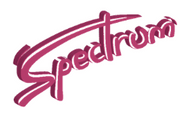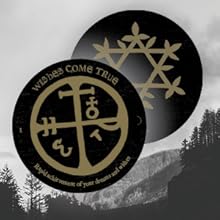Wishes Come True (CARD 1)
rapid achievement of your dreams and wishes
Symbol history
This symbol comprises a circle divided into four quarters, representing the four compass directions of north, east, south and west. The vertical line forms a cross, which represents the divine, and the horizontal line characterises a tree, which signifies the material world. In the top right quadrant sits an imperial orb, the globus cruciger, symbolising nobility on earth as well as the archangels in heaven. In the lower left quadrant is a magickal symbol thought to inspire the motivation to achieve great things. In the lower right quadrant is a mark that represents a horseshoe nail, thought to attract faithfulness and dependability. This symbol is from the 16th century and was originally inspired by Key of Solomon, but instead uses Christian symbolism rather than Kabbalistic ones.
|
Protection (CARD 10)
strong protective magick for the family and the home
This symbol is of Viking origin, and is known as the Helm of Awe. Its first known incarnation appears in the 16th-century Icelandic book of magick, Galdrabók, as spell number 41. It was originally designed to generate victory over one’s enemies. The Helm of Awe is comprised of the Norse runes algiz, for protection, and isa, for standstill, to stop negative energies in their tracks. Legends suggest that Viking warriors used to paint this symbol between their eyebrows before going into battle, to ensure triumph and shield them from harm.
|
Faery Magick (CARD 13)
respectfully work with the faeries to achieve your goals
The carving of the original faery magick symbol is situated inside the stone chamber of a megalithic burial site in County Waterford, Ireland, and has been dated at around 4,500 BC. It is a glyph carved into a large stone and is studded with tiny crystals. Within the cave are many additional spiral carvings but this one is larger and stands alone, much the same as the triple spiral symbol at Newgrange. This is a powerful glyph associated with the Sidhe people (pronounced ‘shee’), an ancient race who lived in the British Isles before humans and often referred to as the ‘faery folk’. Indeed, the small village where the stone tomb is located is known as Gortnasheen: the place of the faeries. The faery race is not of the physical world but exists on the astral plane and lives side by side with us.
|
Star (CARD 21)
the silver energy of a star creates good luck and serendipity
This eight-pointed star, otherwise known as an octagram, is a powerful tool in sacred geometry, or the practice of assigning special meaning to geometric shapes. The eight-pointed star symbol is referenced in many world religions, but holds special meaning in Buddhism, Christianity and Paganism. In Buddhism, an octagram represents the eight-fold path of reaching enlightenment. In Christianity, the eight-pointed star signifies the star of Bethlehem, and in Paganism it represents the wheel of the year. This symbol is also known as the alchemical symbol for creation, of manifesting material desires.
|





























